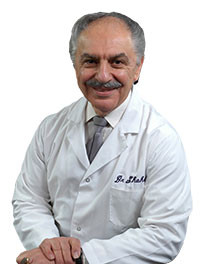Ganglion Cyst Removal in Midland Park, NJ
What Is a Ganglion Cyst?

A ganglion cyst is a benign, noncancerous tumor that usually forms on the back of the wrist. Although they are considered harmless sacks of clear, jelly-like fluid, these cysts can vary in size and sometimes put pressure on surrounding nerves, causing aching pain. Treatment usually involves a minimally-invasive procedure to remove the fluid from the cyst.
To schedule a consultation with a healthcare practitioner in Midland Park who specializes in ganglion cyst treatment, call (201) 806-6099 or contact Dr. M.T. Shahab online.
Ganglion Cyst Causes & Symptoms
The cause of ganglion cysts is currently unknown. It is thought that joint or tendon irritation might cause them to form. They may also form due to an injury or trauma in a particular area. Although they commonly form on the hand, ganglion cysts can also form on the outside of the knee and ankle, the top of the foot, or at the base or end of the finger.
There are certain factors that may increase your risk of developing a ganglion cyst. Although they can develop in anyone of any age, they are most commonly found in woman between 20 to 40 years old. Individuals who have arthritis in the finger joints closest to their fingernails, as well as people who have had past joint or tendon injuries, are at a greater risk as well.
The size of ganglion cysts can vary from the size of a pea to 2.5 centimeters in diameter. The symptoms of ganglion cysts usually correlate with size. Depending on the size and location, a ganglion cyst can sometimes interfere with joint movement. In addition to persistent pain, other ganglion cyst symptoms include numbness, a tingling sensation, and a feeling of muscle weakness.
Ganglion Cyst Diagnosis & Treatment Options
If you experience ganglion cyst symptoms, there are several ways for your healthcare practitioner to formally diagnose your condition. The first step is to determine if the lump is solid or fluid-filled, as a solid lump can be caused by another condition. One of the easiest ways to answer this question is to hold a light to the cyst and see if light shines through it; fluid is translucent, while solid materials are not. An X-ray can also be used to rule out other conditions, as a fluid-filled cyst will not show up on an X-ray. Magnetic resonance imaging (MRIs) and ultrasounds are very good at showing soft tissues, and can be used to determine if the cause of the bump is actually arthritis, a bone tumor, or a blood vessel or artery.
Many ganglion cysts will disappear on their own. However, there are various ways that your healthcare practitioner can treat your ganglion cyst. Ganglion cyst treatment may include home remedies, immobilization, non-surgical and surgical procedures. It should be noted that these treatments only reduce or remove the cyst, and that there is always a likelihood that the cyst can return.
Home Remedies and Immobilization
In the past, ganglion cysts were sometimes called bible cysts or bible bumps, as a common home remedy was to "thump" the cyst with a heavy object, often a bible. However, this is no longer recommended, as hitting your body in such a way can actually cause more damage. One home remedy that is still recommended in bible cyst treatment is over-the-counter pain medication, which can be used to relieve pain. If the cyst is on the foot or ankle, wearing more comfortable shoes can relieve pressure. It is important that you do not try to pop the cyst on your own, as this could lead to infection.
To prevent the ganglion cyst from increasing in size, your healthcare practitioner might recommend that the cyst area be immobilized with a brace or splint. By immobilizing the area, the cyst may shrink in size, relieving pressure and pain. Splints should not be used for too long a time because they could lead to the surrounding muscle becoming weak.
Non-Surgical and Surgical Treatments
If immobilization does not eliminate your cyst, removing a ganglion cyst might be necessary. The most common non-surgical method to cure a cyst is called aspiration. During this procedure, a needle in inserted into the cyst, and its fluid is removed into a syringe. This will cause the cyst to decrease in size. Afterward, your healthcare provider may inject a steroid compound into the area in order to reduce inflammation.
If immobilization or aspiration do not work, ganglion cyst removal surgery might be necessary. This method of bible bump removal involves surgically cutting into the patient's skin and completely removing the cyst, stalk and tendon sheath. After the surgery, the joint will be splintered for about seven to ten days.
Don't let a painful cyst interfere with your wellbeing. If you are experiencing a ganglion cyst that is causing you discomfort, you are not without options. To schedule an appointment with a practitioner in Midland Park who can address your wrist pain, call (201) 806-6099 or contact Dr. M.T. Shahab online.
Medwell Orthopedics & Functional Medicine for Men & Women
Address
33 Central AveMidland Park, NJ 07432
(201) 806-6099
www.BergenCountyDoctors.com
Hours
Mon:
8:00 am - 8:00 pm
Tue:
2:00 pm - 7:00 pm
Wed:
8:00 am - 6:30 pm
Thu:
8:00 am - 1:00 pm
Fri:
8:00 am - 6:30 pm
Sat:
9:00 am - 1:00 pm
Sun:
By Appointment Only


